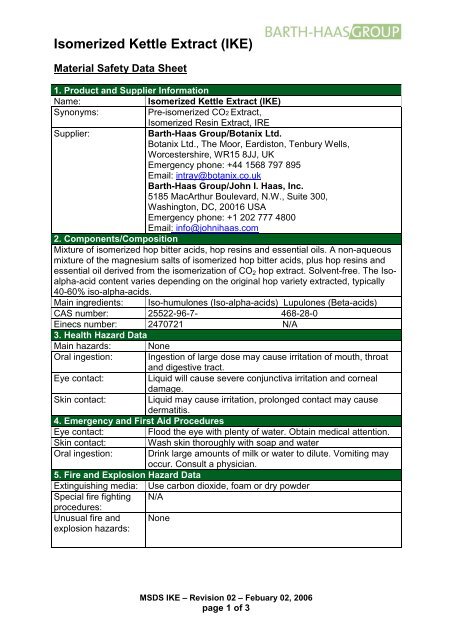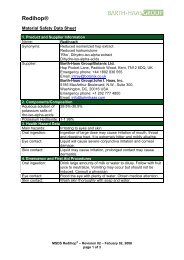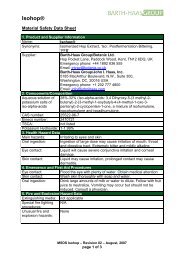Isomerized Kettle Extract (IKE)
Isomerized Kettle Extract (IKE)
Isomerized Kettle Extract (IKE)
Create successful ePaper yourself
Turn your PDF publications into a flip-book with our unique Google optimized e-Paper software.
<strong>Isomerized</strong> <strong>Kettle</strong> <strong>Extract</strong> (<strong>IKE</strong>)<br />
Material Safety Data Sheet<br />
1. Product and Supplier Information<br />
Name: <strong>Isomerized</strong> <strong>Kettle</strong> <strong>Extract</strong> (<strong>IKE</strong>)<br />
Synonyms: Pre-isomerized CO2 <strong>Extract</strong>,<br />
<strong>Isomerized</strong> Resin <strong>Extract</strong>, IRE<br />
Supplier: Barth-Haas Group/Botanix Ltd.<br />
Botanix Ltd., The Moor, Eardiston, Tenbury Wells,<br />
Worcestershire, WR15 8JJ, UK<br />
Emergency phone: +44 1568 797 895<br />
Email: intray@botanix.co.uk<br />
Barth-Haas Group/John I. Haas, Inc.<br />
5185 MacArthur Boulevard, N.W., Suite 300,<br />
Washington, DC, 20016 USA<br />
Emergency phone: +1 202 777 4800<br />
Email: info@johnihaas.com<br />
2. Components/Composition<br />
Mixture of isomerized hop bitter acids, hop resins and essential oils. A non-aqueous<br />
mixture of the magnesium salts of isomerized hop bitter acids, plus hop resins and<br />
essential oil derived from the isomerization of CO2 hop extract. Solvent-free. The Isoalpha-acid<br />
content varies depending on the original hop variety extracted, typically<br />
40-60% iso-alpha-acids.<br />
Main ingredients: Iso-humulones (Iso-alpha-acids) Lupulones (Beta-acids)<br />
CAS number: 25522-96-7- 468-28-0<br />
Einecs number: 2470721 N/A<br />
3. Health Hazard Data<br />
Main hazards: None<br />
Oral ingestion: Ingestion of large dose may cause irritation of mouth, throat<br />
and digestive tract.<br />
Eye contact: Liquid will cause severe conjunctiva irritation and corneal<br />
damage.<br />
Skin contact: Liquid may cause irritation, prolonged contact may cause<br />
dermatitis.<br />
4. Emergency and First Aid Procedures<br />
Eye contact: Flood the eye with plenty of water. Obtain medical attention.<br />
Skin contact: Wash skin thoroughly with soap and water<br />
Oral ingestion: Drink large amounts of milk or water to dilute. Vomiting may<br />
occur. Consult a physician.<br />
5. Fire and Explosion Hazard Data<br />
Extinguishing media: Use carbon dioxide, foam or dry powder<br />
Special fire fighting N/A<br />
procedures:<br />
Unusual fire and<br />
explosion hazards:<br />
None<br />
MSDS <strong>IKE</strong> – Revision 02 – Febuary 02, 2006<br />
page 1 of 3
6. Accidental Release/Spill measures<br />
Personal protection: Wear appropriate protective clothing.<br />
Environmental<br />
precautions:<br />
Prevent material from entering drains or water courses.<br />
Contain spillage using earth, sand or other inert absorbent material. Scoop/shovel<br />
into disposal container. Flush area with hot soapy water to remove final traces. Use<br />
adequate ventilation or a respirator if in a confined area.<br />
7. Handling and Storage<br />
Storage temperature: • 15-25 °C (60-77 °F)<br />
Keep container closed when not in use. Use open containers as soon as possible<br />
Suitable storage is high grade stainless steel, glass, high density polyethylene and<br />
high phenolic lacquered mild steel.<br />
8. Exposure Controls/Personal Protection<br />
Respirator: Not required<br />
Hand protection: PVC or rubber gloves<br />
Body protection: If danger of splashing wear PVC or rubber apron.<br />
Eye protection: Chemical goggles must be worn during handling.<br />
9. Physical and Chemical Properties<br />
Form: Viscous/liquid<br />
Colour: Yellow/orange to brown/green<br />
Odour: Characteristic, resinous aroma<br />
Boiling Point: Above 100 °C (212 °F)<br />
Density (kg/m 3 ): 850-1000<br />
Solubility: Soluble in nearly all organic solvents,<br />
water causes formation of an emulsion.<br />
Flash point: > 100 °C<br />
10. Stability and Reactivity<br />
Combuston will generate oxides of carbon, small amounts of aldehydes, ketones and<br />
alcohols. Stable under normal conditions. No known incompatibilities.<br />
11. Toxicological Information<br />
No TLV’s established. Low order of acute toxicity<br />
12. Ecological Information<br />
Mobility: No part of product will dissolve rapidly in water.<br />
Bioaccumulation: Product is not expected to bioaccumulate.<br />
Exoticity: no data<br />
13. Disposal Considerations<br />
Product disposal: Dispose of in accordance with all applicable local and national<br />
regulations.<br />
Container disposal: Labels should not be removed from containers until they have<br />
been cleaned. Contaminated containers should not be treated<br />
as household waste. Containers should be cleaned using<br />
appropriate methods and then re-used or disposed of by<br />
landfill or incineration as appropriate.<br />
MSDS <strong>IKE</strong> – Revision 02 – Febuary 02, 2006<br />
page 2 of 3
14. Transport Information<br />
UN-No: N/C RID: N/C<br />
Class: N/C Packing Group: N/C<br />
15. Regulatory Information<br />
Labelling according to US and EC regulations<br />
R-phrases: None<br />
S-phrases: None<br />
16. Other Information<br />
The information in this Safety Data sheet is correct to the best of our knowledge. This<br />
information should be used only as a supplement to information already in your<br />
possession concerning this product. The determination of whether and under what<br />
condition the product should be used by your employees is yours to make. We do not<br />
accept any liability for loss, injury or damage that may result from its use.<br />
MSDS <strong>IKE</strong> – Revision 02 – Febuary 02, 2006<br />
page 3 of 3





